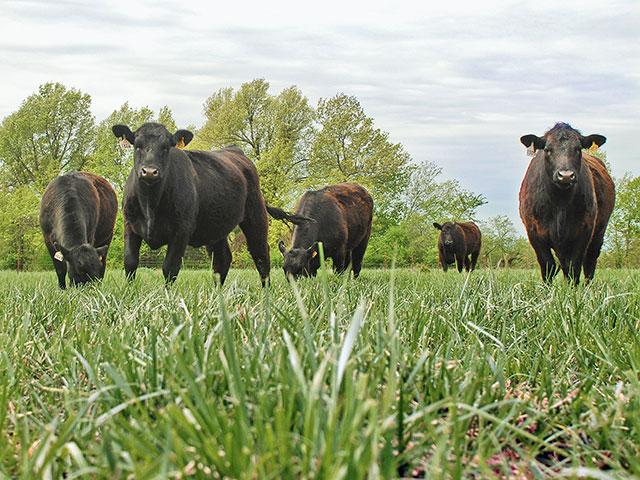Forage Production Faces Challenges
Severe Drought, Less Fertilizer Application Could Limit Forage Production
OMAHA (DTN) -- Severe drought and high fertilizer costs that are causing some forage growers to cut back on applications might limit overall forage production this growing season. This situation could haunt livestock producers who are in the market for forages in the coming months, according to Extension specialists.
TEXAS DROUGHT LIMITS FORAGES
A severe drought has gripped most of Texas this growing season. Except for the southern tip of the state, most of the Lone Star State is in some drought designation, according to the U.S. Drought Monitor (https://droughtmonitor.unl.edu/…).
The Grassland Prediction Forecast, Grasscast (https://grasscast.unl.edu/…), shows that even with above-normal precipitation between now and Aug. 31, the Texas Panhandle could see anywhere from 5% to 30% less production. If precipitation is below normal, most of the region will see losses closer to 30%.
Vanessa Corriher-Olson, Texas A&M AgriLife Extension forage specialist based in Overton in east Texas, told DTN forage production in Texas will likely see a decline because of the severe drought. High heat -- with many days of triple-digit temperatures -- hasn't helped the situation either, she said.
Some Texas forage producers also cut back on their fertilizer applications this spring due to high prices. Hay nutritive value can be affected by several factors, including drought and less fertilizer application.
Corriher-Olson said she hopes most hay producers know what affects nutritive value and will make appropriate management decisions to maximize value.
But this year, most people are more concerned about producing any hay at all, Corriher-Olson said.
While it is only July, some Texas livestock producers are already concerned about the forage supply this winter.
"I'm already getting questions about alternative to feeding hay this winter," Corriher-Olson told DTN. "If we have less hay, producers will have to cull animals or utilize other alternatives."
P[L1] D[0x0] M[300x250] OOP[F] ADUNIT[] T[]
These alternatives could include buying hay from other states, utilizing other harvested forages or even planting winter pastures, she said.
Corriher-Olson said this lack of forage supply in Texas will cause forage prices to increase. Prices have already gone up for hay because of the lack of supply, she said.
IOWA FORAGE CHALLENGES
While it isn't experiencing as extreme of drought as Texas, Iowa is having its own forage growing season challenges.
According to the Drought Monitor map, several different drought designations are present in the Hawkeye State, including extreme drought in northwestern Iowa.
Pasture production is variable in the state for several reasons, according to Erika Lundy-Woolfolk, Iowa State University Extension beef field specialist located in southwestern Iowa. Drought and fewer fertilizer applications certainly factor in, but other things like past management play a larger role, she said.
For well-managed grasslands that have not been overgrazed in recent years, cool-season pastures did quite well regardless of nutrient applications. However, overgrazed pastures -- or even pastures where cows were turned out too early this spring -- are probably seeing lower yields, she said.
"Most farmers probably don't fertilizer pastures annually anyway, so skipping this year due to high prices probably didn't make a huge difference, assuming pastures have seen fertilizer in the last couple of years and are managed adequately," Lundy-Woolfolk said.
"Missing one year of fertilization probably isn't going to have a big impact on forage yield, but it's definitely important to take notes and stay on top of future applications," she said.
Many pastures in southern Iowa are predominately fescue-based, and this grass responds better to a fertilizer application in the fall rather than the spring, she said. Fescue will respond more aggressively than other cool-season grasses to nitrogen application.
Lundy-Woolfolk said higher uptake of nitrogen exacerbates alkaloid production, thus making fescue toxic after fertilization. During the fall regrowth, alkaloid production is lower compared to spring growth, which makes fall nitrogen application more desirable.
Iowa cow-calf producers are always looking for ways to manage input costs without sacrificing cow herd performance, she said. This is especially true in these times of high feed prices.
Lundy-Woolfolk said practices such as improving grazing utilization through rotational grazing, looking for more opportunities to graze low-quality forages like cornstalks or CRP acres, adjusting stocking densities to better match forage productivity, and strategic supplement feeding are all areas producers will be considering.
PSU: LIMIT PASTURE INPUT COSTS
Certain management practices can help reduce input costs in pasture management, according to a recent Penn State University news release (https://extension.psu.edu/…). These include soil testing, planting legumes and rotational grazing.
Pasture managers need to examine every aspect of their management program to determine where money can be saved. Soil testing remains very important to help guide fertility management, according to the release.
Planting legumes can provide the chance to reduce or eliminate supplemental nitrogen application to pasture. Red clover and white clover are the best choices in Pennsylvania in most situations.
An effective rotational grazing system will aid in nutrient distribution. Moving livestock to new paddocks every few days helps distribute manure and urine more effectively across the farm, compared to continuous grazing, according to the release.
In addition, rotational grazing prevents nutrient excesses from building up in certain areas such as alleys or near waterers.
Russ Quinn can be reached at Russ.Quinn@dtn.com
Follow him on Twitter @RussQuinnDTN
(c) Copyright 2022 DTN, LLC. All rights reserved.






